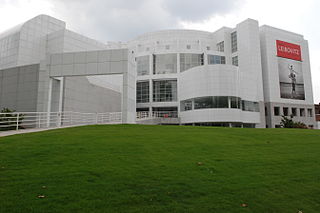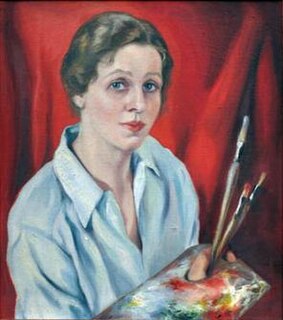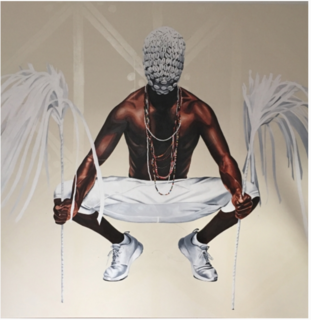Alfred Amadu Conteh | |
|---|---|
| Born | 1975 Fort Valley, Georgia |
| Nationality | American |
| Alma mater | Hampton University Georgia Southern University |
Alfred Amadu Conteh is an American sculptor, painter and mixed-media artist.
Contents

Alfred Amadu Conteh | |
|---|---|
| Born | 1975 Fort Valley, Georgia |
| Nationality | American |
| Alma mater | Hampton University Georgia Southern University |
Alfred Amadu Conteh is an American sculptor, painter and mixed-media artist.

Alfred Amadu Conteh was born in 1975 in Fort Valley, Georgia. He attended Hampton University in Hampton, Virginia, where he received a BFA. He received his MFA from Georgia Southern University in Statesboro, Georgia. His mother is African American and his father is from Sierra Leone, West Africa. Many of his works examine his personal identity through his parents' experiences and cultural differences. Along with paintings, Conteh creates organic contemporary sculpture that uses symbology to express his narratives of the African American southern experience." [1] Conteh uses a variety of media as a vehicle to provoke thought that will result in change." [2]

Alfred Amadu Conteh began exhibiting in 2003 and since then he has participated in over 12 solo exhibitions and many group exhibitions. Conteh's work has caused controversial responses in some instances. His exhibition at Tubman Museum in 2015 in Macon, Georgia, caused a stir amongst religious leaders who found his piece "Preacher Pimp" offensive. "Conteh's "pimp" series features a variety of people and their wrongdoings to others. Among those included are the "Athlete Pimp," “Property-Owning Pimp" and "Mother Pimp." The series highlights the dark side of how we interact with others and treat them, Conteh said. "Preacher Pimp" reflects the religious leaders whose actions are unethical but isn't representative of all of church leaders, Conteh said." [3] [4]
Alfred Conteh's recent series, "Two Fronts", is a visual exploration of how people of the African Diaspora in the South are facing economic, educational, and psychological wars. His recent exhibition at September Gray Gallery in Atlanta, Georgia, garnered critical review from the Atlanta Journal-Constitution. "Conteh’s treatment of his subjects affirms the centrality of these people as representatives of the human condition: the mothers and workers and children and hustlers as worthy of their own commemoration." [5]
Alfred Amadu Conteh has gained a national following. He has exhibited at several museums and galleries including, Tubman Museum in Macon, Georgia, Museum of Arts an Sciences, Hudgens Center for the Arts, and Art Basel Miami. His work has been collected and exhibited widely throughout the South." [6]

Jacob Armstead Lawrence was an American painter known for his portrayal of African-American historical subjects and contemporary life. Lawrence referred to his style as "dynamic cubism", although by his own account the primary influence was not so much French art as the shapes and colors of Harlem. He brought the African-American experience to life using blacks and browns juxtaposed with vivid colors. He also taught and spent 16 years as a professor at the University of Washington.

John Thomas Biggers was an African-American muralist who came to prominence after the Harlem Renaissance and toward the end of World War II. Biggers created works critical of racial and economic injustice. He also served as the founding chairman of the art department at Houston's Texas State University for Negroes, a historically black college.

The High Museum of Art is an art museum in Atlanta, Georgia in the Southeastern United States. Located on Peachtree Street in Midtown, the city's arts district, the High is a division of the Woodruff Arts Center.

Beverly Buchanan was an African-American artist whose works include painting, sculpture, video, and land art. Buchanan is noted for her exploration of Southern vernacular architecture through her art.

Samella Sanders Lewis was an American visual artist and art historian. She worked primarily as a printmaker and painter. She has been called the "Godmother of African American Art". She received Distinguished Artist Award for Lifetime Achievement from the College Art Association (CAA) in 2021.
“Art is not a luxury as many people think – it is a necessity. It documents history – it helps educate people and stores knowledge for generations to come.” – Dr. Samella Lewis
The Highwaymen, also referred to as the Florida Highwaymen, are a group of 26 African American landscape artists in Florida. Two of the original artists, Harold Newton, and Alfred Hair, received training from Alfred “Beanie” Backus. It is believed they may have created a body of work of over 200,000 paintings. They challenged many racial and cultural barriers. Mostly from the Fort Pierce area, they painted landscapes and made a living selling them door-to-door to businesses and individuals throughout Florida from the mid-1950s through the 1980s. They also sold their work from the trunks of their cars along the eastern coastal roads.
Mildred Jean Thompson was an American artist who worked in painting, drawing, printmaking, sculpture and photography. Critics have related her art to West African textiles and Islamic architecture; they have also cited German Expressionism, music and Thompson's readings in astronomy, spiritualism and metaphysics as important artistic influences. She also wrote and was an associate editor for the magazine Art Papers.

Jack Whitten was an American painter and sculptor. In 2016, he was awarded a National Medal of Arts.

The Tubman Museum, formerly known as the "Tubman African American Museum", is located in Macon, Georgia, USA. It is located in the city's museum district near the Georgia Music Hall of Fame and Georgia Sports Hall of Fame.
Amalia K. Amaki is an African-American artist, art historian, educator, film critic and curator who recently resided in Tuscaloosa, Alabama, where she was Professor of Modern and Contemporary Art at the University of Alabama at Tuscaloosa from 2007 to 2012.
William Sidney Arnett was an Atlanta-based writer, editor, curator and art collector who built internationally important collections of African, Asian, and African American art. Arnett was the founder and chairman of the Souls Grown Deep Foundation, an organization dedicated to the preservation and documentation of African American art from the Deep South that works in coordination with leading museums and scholars to produce groundbreaking exhibitions and publications using its extensive holdings. His efforts produced 13 books with nearly 100 essays by 73 authors. 38 museums have hosted major exhibitions, and comprehensive archives are maintained at UNC Chapel Hill. The White House has shown the collection. Arnett exhibited works from these collections and delivered lectures at over 100 museums and educational institutions in the United States and abroad. He is perhaps best known for writing about and collecting the work of African American artists from the Deep South. Arnett was named one of the "100 Most Influential Georgians" by Georgia Trend Magazine in January 2015. He died on August 12, 2020.

Frederick J. Brown was a New York City based visual artist originally from Chicago. His style ranges from abstract expressionism to figurative. His art work was influenced by historical, religious, narrative and urban themes. He is noted for his extensive portrait series of jazz and blues musicians.
Lorenzo Scott was born in 1934 in West Point, Georgia. Scott is a contemporary American artist whose work gained prominence in the late 1980s.
Alex Brewer, also known as HENSE, is an American contemporary artist, best known for his dynamic, vivid and colorful abstract paintings and monumental wall pieces. He has been active since the 1990s. In 2002 he began accepting commissions for artwork and over the course of the last decade has established a solid reputation as a commissioned artist, having appeared in several solo and group shows.
Wini "Akissi" McQueen is an American quilter based in Macon, Georgia. Her artistic production consists of hand-dyed accessories and narrative quilts. Her techniques for her well-known quilts include an image transferring process. In her work, she tackles issues of race, class, society, and women. Her quilts have featured in many museum exhibitions, including the Museum of African American Folk Art, the Taft Museum, the Bernice Steinbam Gallery, and the William College Art Museum. In 2020, her quilts were featured in a retrospective dedicated to her textile art at the Museum of Arts & Sciences in Macon, GA.

Willie Little is a conceptual, multimedia, installation artist and storyteller, whose work is strongly influenced by traditions of rural North Carolina.

Mary E. Hutchinson (1906–1970) was an artist and art instructor from Atlanta who lived and worked in New York City during the years of the Great Depression and World War II. She specialized in figure painting, particularly portraits of female subjects. New York critics described these portraits as "sculptural," having a "bold yet rhythmic design," and often possessing a "haunted mood". Critics noted the "introspective" nature of some portraits whose subjects showed "an almost morbidly brooding sensitiveness." From 1934 to 1943 she was a member of the Art Teaching Staff of the WPA New York Federal Art Project. Following her return to Atlanta in 1945 Hutchinson was an art teacher in Catholic high schools.
Sedrick Ervin Huckaby (1975) is an American artist known for his use of thick, impasto paint to create murals that evoke traditional quilts and his production of large portraits that represent his personal history through images of family members and neighbors.

Fahamu Pecou is an American painter and scholar. He is known for producing works that combine aspects of Fine art and Hip-hop. Most of his works engage representations of black masculinity and identity.

William E. Holmes was a Baptist minister and educator and president of Central City College in Macon, Georgia for 25 years. Before his term at Central City, he was a professor at the Atlanta Baptist Institute. He was also secretary of the board at Spelman College.